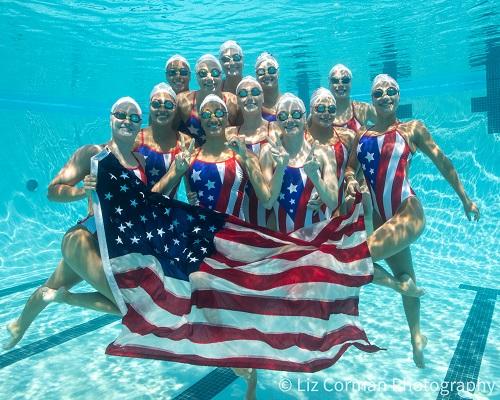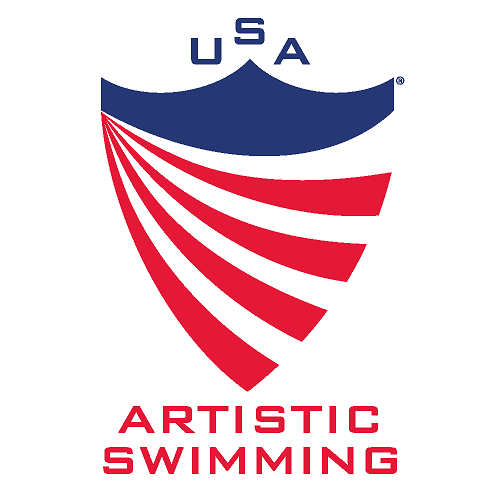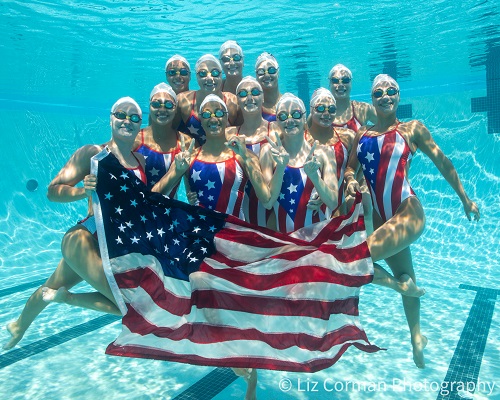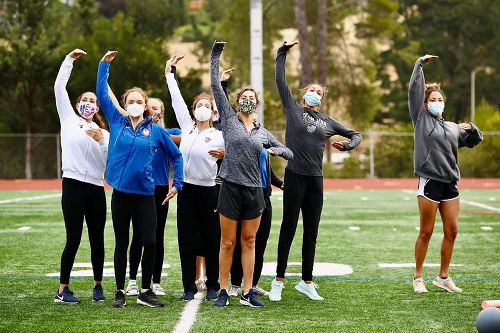
 www.teamusa.org/USA-Artistic-Swimming
www.teamusa.org/USA-Artistic-Swimming
USA Artistic Swimming was originally established as U.S. Synchronized Swimming, also known as USA Synchro, is a nonprofit organization, in 1979 and is the USA's national governing body for the sport. It is recognized by the International Olympic Committee, the United States Olympic Committee and FINA (Federation Internationale de Natation Amateur).
Three events are currently recognized internationally in artistic swimming: solo, duet (two swimmers), mixed duet (one male, one female swimmer), team (eight swimmers) highlight (10 swimmers), combination (10 swimmers). Duet and Team are the events competed at the Olympic Games.
USAAS organizes, participates in and promotes a variety of competitive events each year. These events begin at the local level and continue in the following categories: Age Group (12U-19), Junior (15-18), Senior and Masters (20+). USAAS also owns the rights to the Collegiate National Championships.
Note: For information on hosting USA Artistic Swimming’s events, click here.
Sports Destination Management: The Olympics will be this summer. The last time we saw the sport contested, it was still known as synchronized swimming. What brought about the change?
Adam Andrasko: FINA made the decision to change the name. It came out of a widespread misconception that synchronized swimming meant everyone was swimming in sync with one another when really, they’re swimming in sync with the music. To look at it another way, synchronized diving is a sport whether the athletes are truly moving in sync with one another.

Andrasko: I don’t feel like either name does the sport a disservice. Our tagline is “We move as one.” We were able to leverage that to stay connected to our membership, even during COVID. It was like a rebirth and an organizational reset.
SDM: How has COVID impacted the team?
Andrasko: From the time COVID hit us, our team went into quarantine. They used social media to let our membership and the rest of the world into their lives. They spent 76 days in true quarantine, and as an athlete in a team sport, that is a significant amount of time. On June 16, they were finally able to return to the pool and have trained COVID free since that time.
SDM: Where do you practice?
Andrasko: We train at Campolindo High School in Moraga, California. There is a dive well where we have priority use. The team trains six days a week: each morning there’s an hour of strength and conditioning, and then they work in the pool for six to seven hours. They get Sundays off.
SDM: Do you think people misunderstand the level of work and the level of difficulty?
Andrasko: Yes – I have gone on record as saying it’s the most underappreciated sport there is, and that our athletes train harder than any others in any Olympic sport. This is obviously debatable, but we’re training eight hours a day, six days a week. I would say that triathletes and modern pentathlon get really close to the level of what we’re doing – but overall, it’s an incredible amount of work. It’s not just a time commitment; it’s a lifetime commitment. The sport requires attention to detail whether you’re swimming or floating and there are some very specific nuances to be aware of.
 SDM: Athletes must start pretty young.
SDM: Athletes must start pretty young.
Andrasko: They do. A 16-year-old dancer might be able to transition to doing the movements really well but hasn’t been trained underwater. We also see athletes coming in from gymnastics dance and cheer. If they transition at a young age, they can be great, but the technical skills are hard to pick up in later stages of an athletes career.
SDM: How do people find the sport? Is it usually because a friend or family member is involved?
Andrasko: There’s not really one singular avenue but we do see a few common stories. One is, yes, a friend or family member was doing it and it looked fun. More commonly, though, someone will be at a swimming practice, “speed swimming,” as our athletes typically refer to standard swimming, and they see a group of athletes training for artistic swimming, and they get interested that way.
SDM: When it comes to recruiting new athletes, where does USA Artistic Swimming begin? Is it a varsity sport?
Andrasko: The only state in the country that hosts high school championships in artistic swimming in Minnesota, although on the club level, California, Florida, Texas and Arizona are the primary hotbeds of the sport. We have strong club support across the country and many high schools it as a sport at that club level. If you look at Team USA, it’s made up almost exclusively of club standouts.
SDM: Team USA has not competed in the Olympics in a few years.
Andrasko: The U.S. has not qualified for an Olympics team event, the eight-person event, since 2008, although we have had a duet entered each time. In 1996, our team won gold. In 2000, we finished fifth. In 2004, we won bronze and in 2008, we came in fifth. Since then, we have been trying to qualify.
SDM: Will you be in Tokyo?
Andrasko: Officially, we don’t know yet. The Olympic qualifier we were supposed to take part in, which was going to be in Tokyo, had to be postponed for a third time. We’re waiting to see when it will be rescheduled. We have an incredible team and duet, so yes, I strong believe we will be in Tokyo.
 SDM: What do you think Team USA’s chances are?
SDM: What do you think Team USA’s chances are?
Andrasko: We are extremely optimistic. But this is a judged sport, and we are positioned to take the last spot, and for that, we’re competing against France and Greece. We competed in March of 2020 and we beat France, but that was a long time ago. We’ve also hosted a virtual meet and we did well.
COVID has been hard in many ways but our national team has endured and accomplished some amazing things over the last two years. Their resiliency in 2020 is tremendous. We attempted to capture it in 1:45 seconds in this video. You will hear the voice of Andrea Fuentes who is our Head Coach and the most decorated female Olympian in the history of Spain. She has quickly captured the crown of the most creative coach in the entire sport. It is because of her that we are where we are and when I say we, I don’t just mean the National Team. Her work, their influence and the work of the office staff behind the scenes has changed the culture of the sport across the country and at every level.
SDM: Many sports have told us they see a bounce after the Olympic Games. Does artistic swimming?
Andrasko: Yes, it averages a 2 to 4 perfect increase after the Olympics.
SDM: One new aspect of artistic swimming has been mixed duet, with a man and woman swimming together, sort of like pairs figure skating or ice dancing.
Andrasko: Mixed duet is a world championship event, and we hosted the first male solo at our virtual event. In fact, we have Bill May, one of the most decorated male artistic swimmers, working with our team.
SDM: Moving forward, what changes would you as an executive like to see in artistic swimming?
Andrasko: My biggest effort long term is athlete retention. Currently, this sport does not fund athletes adequately. We need to continue to commit to finding ways to do that. Regardless of how this team does with regard to the Olympics, these athletes – and any future athletes – deserve to be compensated for their time. And we are working to get there. It’s not a conversation around a few thousand dollars but around about half a million so that they can live a healthy lifestyle when they’re not training so hard. We have to ask ourselves. “How do we build amateurism and build it appropriately so that we can fund it?” This is an important question, and it needs to be asked – and answered.

